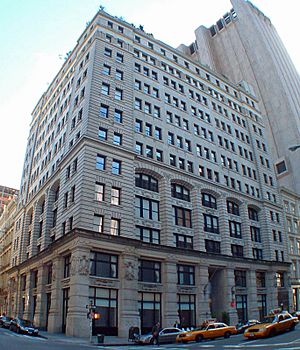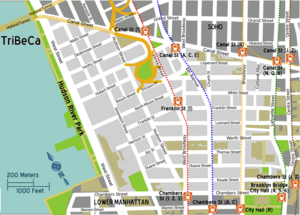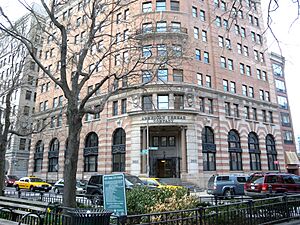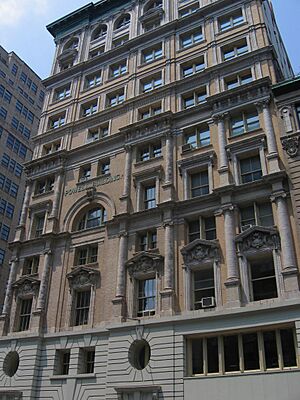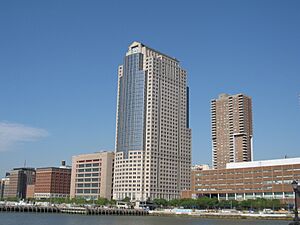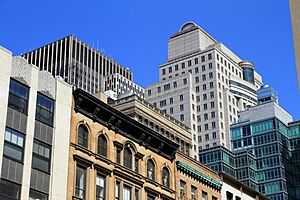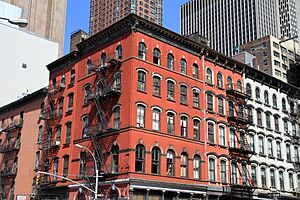Tribeca facts for kids
Quick facts for kids
Tribeca
|
|
|---|---|
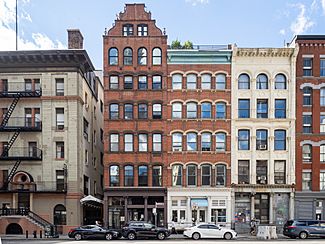
Hudson Street in Tribeca
|
|
| Country | |
| State | |
| City | New York City |
| Borough | Manhattan |
| Community District | Manhattan 1 |
| Area | |
| • Total | 2.35 km2 (0.909 sq mi) |
| Population | |
| • Total | 42,742 |
| • Density | 18,155/km2 (47,021/sq mi) |
| Economics | |
| • Median income | $196,692 |
| ZIP Codes |
10007, 10013
|
| Area codes | 212, 332, 646, and 917 |
Tribeca is a cool neighborhood in Lower Manhattan, New York City. Its name is a short way of saying "Triangle Below Canal Street." This "triangle" area is actually more like a four-sided shape. It is bordered by Canal Street, West Street, Broadway, and Chambers Street. Sometimes, to make properties sound more appealing, people might say Tribeca goes a bit further south.
This area started as farmland a long time ago. Then it became a place where people lived in the early 1800s. Later, it turned into a busy market for goods like food and clothes. After that, artists moved in, followed by actors, models, and other famous people. Tribeca is also home to the Tribeca Festival. This festival was started after the September 11 attacks to help the neighborhood and downtown area recover and feel lively again.
Tribeca is part of Manhattan Community District 1. Its main ZIP Codes are 10007 and 10013. The New York City Police Department's 1st Precinct keeps the area safe.
Contents
What's in a Name?
Tribeca is one of many neighborhoods in New York City with a name that's a syllabic abbreviation. This means its name is made from the first parts of other words. Think of it like a nickname! Other examples include:
- SoHo: South of Houston Street
- NoHo: North of Houston Street
- Nolita: North of Little Italy
- NoMad: North of Madison Square
- DUMBO: Down Under the Manhattan Bridge Overpass
The name "Tribeca" was first used in the early 1970s. It originally described a smaller area that looked like a triangle on city maps. Residents in this area formed a group called the TriBeCa Artists' Co-op. They used this name when dealing with a zoning issue in 1973. An article in The New York Times in 1976 mentioned the name. It said the City Planning Commission had made the name official. The article also said the name covered a larger area than it originally did. This is how "Tribeca" became the name for the neighborhood we know today.
A Look Back: Tribeca's History
Early Days
The land that is now Tribeca was first farmed by Dutch settlers. This was back when New York was called New Amsterdam. One important settler was Roeleff Jansen. His family owned the land until 1670. Then, the English took control of the area.
Later, in 1705, a large part of this land was given to Trinity Church by Queen Anne. In 1807, the church built St. John's Chapel. They also created St. John's Park, which was surrounded by nice brick houses. This area was one of the first places in New York City to be developed for people to live. It stayed mostly residential until the 1840s.
Some streets in Tribeca are named after the Lispenard family. For example, Lispenard Street is named for them. Beach Street was also created around this time. Its name comes from Paul Bache, who was related to the Lispenard family.
From Markets to Modern City
In the 1840s, shipping in New York City started to change. More ships began using the Hudson River instead of the East River. This was because the Hudson River had longer piers for bigger ships. Also, it became easier for ships to enter New York Harbor from the Atlantic Ocean.
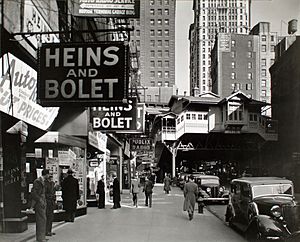
This increase in shipping helped the Washington Market grow. This market, which started in 1813, sold fruits and vegetables wholesale. It expanded into many buildings in the neighborhood. By the mid-1800s, Tribeca was also a big center for dry goods and textiles. St. John's Park was even turned into a place for freight trains. Later, the area had stores selling fireworks, pets, radios, and sporting goods. Many of the radio stores were removed to make way for the World Trade Center.
New transportation also helped Tribeca grow. The New York City Subway extended its lines here in 1918. This made it easier for people and vehicles to get around. An elevated train line also served the area, but it was taken down in 1940.
After the Holland Tunnel was built (1920-1927), more goods were shipped by trucks. This caused a lot of traffic. So, the Miller Highway (also called the West Side Highway) was built above the streets. It was meant for cars to avoid the truck traffic. However, the highway started to fall apart. It was closed in 1973. A new road project called Westway was planned, but people fought against it. Instead, West Street was rebuilt to handle the traffic.
A New Beginning
By the 1960s, Tribeca's factories and markets were mostly gone. The produce market moved to Hunts Point in the Bronx. The city then planned to rebuild the area. They tore down old buildings to make way for new homes, offices, and schools. Some new buildings were constructed, like Independence Plaza in 1975. The Borough of Manhattan Community College opened in 1980, and Washington Market Park in 1981.
Many old warehouse buildings were turned into homes. Artists started living and working in these large spaces, just like they did in nearby SoHo. In the early 1970s, artists in the area, then known as Washington Market, wanted similar rules for their neighborhood. One group called themselves the "Triangle Below Canal Block Association." They shortened it to the Tribeca Block Association. This is how the name "Tribeca" came to be used for the whole area.
In 1996, the Tribeca Open Artist Studio Tour started. It's a group run by artists to show off their work. For 15 years, this free walking tour let people see inside artists' studios. Tribeca was badly affected by the September 11, 2001 terrorist attacks. But with help from the government, the area recovered quickly. The Tribeca Film Festival was created to help Lower Manhattan heal after 9/11. It also celebrates New York City as a place where many movies are made. The festival wants people to "experience the power of film." Tribeca is a popular spot for filming movies and TV shows.
By the early 2000s, Tribeca became one of Manhattan's most popular neighborhoods. Many celebrities live here. Its streets are full of art galleries, unique shops, restaurants, and bars. In 2006, Forbes magazine said Tribeca's 10013 zip code was the most expensive in New York City. As of 2010, Tribeca was considered the safest neighborhood in New York City. In the 2010s, several tall skyscrapers were built, like 30 Park Place and 56 Leonard Street.
| Historical population | |||
|---|---|---|---|
| Census | Pop. | %± | |
| 1950 | 782 | — | |
| 1960 | 382 | −51.2% | |
| 1970 | 370 | −3.1% | |
| 1980 | 5,949 | 1,507.8% | |
| 1990 | 8,386 | 41.0% | |
| 2000 | 10,395 | 24.0% | |
| 2010 | 17,056 | 64.1% | |
Who Lives in Tribeca?
The New York City government groups Tribeca with other Lower Manhattan neighborhoods for census information. In 2010, this larger area had 42,742 people. Most residents are White (66.1%), followed by Asian (22.2%). About 6.5% of the population is Hispanic or Latino.
In 2018, the average life expectancy in Tribeca and nearby areas was 85.8 years. This is higher than the average for New York City. Most people living here are young to middle-aged adults (25-44 years old). About 14% are under 18.
The median household income in Tribeca and nearby areas was $144,878 in 2017. In 2018, only about 9% of residents lived in poverty. This is much lower than the city average. This means Tribeca is a high-income area compared to the rest of the city.
Cool Places to See
Tribeca has many old factory buildings that have been turned into homes and lofts. This is similar to the SoHo-Cast Iron Historic District nearby. In the 1800s and early 1900s, this area was a big center for the textile industry.
Some famous buildings include the Textile Building, built in 1901. Another is the Powell Building on Hudson Street, built in 1892. The New York Telephone Company building at 140 West Street has cool Mayan-inspired designs. The old New York Mercantile Exchange is at 6 Harrison Street.
In the 1960s and 1970s, many artists moved into Tribeca's empty and cheap lofts. They liked the quiet area and the large living spaces. Jim Stratton, an early Tribeca resident, wrote a book about turning these old warehouses into homes.
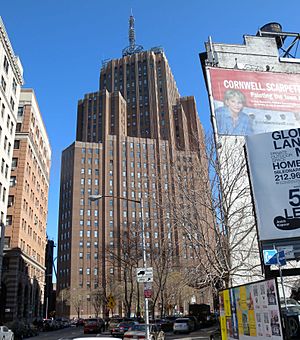
AT&T Long Distance Building at 32 Avenue of the Americas
|
Here are some other notable places:
- 32 Avenue of the Americas: An Art Deco building that used to be a major AT&T office.
- 388 Greenwich Street: An office building that is the headquarters for a part of Citigroup, a big financial company.
- Borough of Manhattan Community College (BMCC): A college that is part of the City University of New York. Its campus is large, covering four blocks.
- Holland Tunnel: The entrance and exit to this tunnel, which connects New York to New Jersey, are in Tribeca.
- Hook & Ladder Company No. 8: This active firehouse on North Moore Street was used in the Ghostbusters movies! You can see movie items inside.
- Hudson River Park: A huge park along the Hudson River. It's about 550 acres, making it Manhattan's second-largest park after Central Park. It was built after plans for a highway were stopped.
- Kitchen, Montross & Wilcox Store: A historic building in Tribeca, built in 1861.
- Metropolitan College of New York: A private college located on Canal Street.
- New York Academy of Art: A graduate art school that teaches technical skills.
- New York Law School: A private law school founded in 1891. It has been in Tribeca since 1962.
- Nutopian Embassy: Located at 1 White Street, this building was once the "embassy" for John Lennon and Yoko Ono's idea of a conceptual country called Nutopia. It's now a restaurant.
- Stuyvesant High School: A famous high school located nearby in Battery Park City. The Tribeca Bridge was built to help students safely cross West Street.
- Verizon Building: A historic building in Tribeca, built between 1923 and 1927. It was turned into apartments in 2016.
- Washington Market Park: A 1.61-acre park popular with kids for its large playground. It also has community gardens and hosts events.
Historic Areas
The city has named several parts of Tribeca as historic districts. This helps protect their special character. These districts were named in the early 1990s:
- Tribeca West
- Tribeca East
- Tribeca North
- Tribeca South
- Tribeca South Extension
Fire Safety
Tribeca is served by two New York City Fire Department (FDNY) fire stations. One is at 100 Duane Street. The other is Ladder Company 8 at 14 North Moore Street, which you might recognize from the Ghostbusters movies!
Mail and ZIP Codes
Tribeca uses two main ZIP Codes for mail. Most of the neighborhood is in 10013. The southern part is in 10007. The United States Postal Service has two post offices nearby: the Federal Plaza Station and the Canal Street Station.
Learning in Tribeca
Tribeca and Lower Manhattan have many residents who have gone to college. About 84% of adults aged 25 and older have a college degree or higher. This is much higher than the average for New York City.
Students in Tribeca and Lower Manhattan do very well in school. The percentage of elementary school students doing well in math went from 61% in 2000 to 80% in 2011. Reading scores also improved. Very few elementary school students miss a lot of school days (only 6%). Also, 96% of high school students in Tribeca and Lower Manhattan graduate on time. This is much higher than the city average.
Schools
The New York City Department of Education runs these public schools nearby:
- PS 150 (for grades Pre-Kindergarten to 5th grade)
- PS 234 Independence School (for grades Kindergarten to 5th grade)
Libraries
The New York Public Library (NYPL) has two branches close by. The New Amsterdam branch is at 9 Murray Street. The Battery Park City branch is at 175 North End Avenue. This two-story library was built in 2010. It's also a "LEED-certified" building, meaning it's designed to be good for the environment.
Famous Faces in Tribeca
- Edward Albee (playwright)
- Laurie Anderson (artist, musician)
- Paul Bettany (actor)
- Beyoncé (singer)
- Jessica Biel (actress)
- Eric Bogosian (actor, playwright)
- Edward Burns (actor, filmmaker)
- Mariah Carey (singer)
- Jennifer Connelly (actress)
- Daniel Craig (actor)
- Billy Crystal (actor, comedian)
- Kid Cudi (rapper, singer)
- Robert De Niro (actor)
- Lena Dunham (writer, director)
- Elvis Duran (radio personality)
- The Edge (musician from U2)
- Bethenny Frankel (businesswoman, TV personality)
- Marián Gáborík (former hockey player)
- Dave Gahan (singer)
- James Gandolfini (actor)
- Sarah Michelle Gellar (actress)
- Heather Graham (actress)
- Savannah Guthrie (journalist)
- Mariska Hargitay (actress)
- Josh Hartnett (actor)
- Chanel Iman (model)
- Michael Imperioli (actor)
- Jay-Z (rapper, entrepreneur)
- Derek Jeter (former baseball player)
- Harvey Keitel (actor)
- Karolina Kurkova (model)
- Chris Martin (singer from Coldplay)
- Danny Masterson (actor)
- Shane McMahon (businessman, wrestler)
- Debra Messing (actress)
- Taylor Momsen (singer, former actress)
- Toni Morrison (novelist)
- Casey Neistat (YouTube personality)
- Gwyneth Paltrow (actress, businesswoman)
- Mike Piazza (former baseball player)
- Amy Poehler (comedian, actress)
- Norman Reedus (actor)
- Lou Reed (musician)
- Kelly Ripa (actress, TV host)
- Richard Serra (artist)
- Jake Shears (singer)
- M. Night Shyamalan (filmmaker)
- Gary Sinise (actor)
- Jon Stewart (comedian, TV host)
- Michael Stipe (singer)
- Meryl Streep (actress)
- Taylor Swift (singer-songwriter)
- Uma Thurman (actress)
- Justin Timberlake (singer, actor)
- Christy Turlington (model)
- Neil deGrasse Tyson (astrophysicist)
- Mo Vaughn (former baseball player)
- Kate Winslet (actress)
- Dean Winters (actor)
Robert De Niro and Jane Rosenthal helped a lot with Tribeca's comeback. They created the TV show TriBeCa in 1993. Then, in 2002, they started the yearly Tribeca Film Festival. De Niro even had a legal issue over who owned website names with "Tribeca" in them, especially if they were about film festivals.
Tribeca in Pop Culture
- The TV show Wizards of Waverly Place has a fictional "Tribeca Prep" school. But the outside shots were filmed at a different school in Manhattan.
- A fictional "Tribeca High School" appears in an episode of Law & Order: Special Victims Unit.
- The local radio station WHTZ has its studio here.
- In the book Winds of Salem, a powerful god from Asgard lives in Tribeca.
- The Subaru Tribeca was a car named after the neighborhood. It was made from 2005 to 2012.
See also
 In Spanish: Tribeca para niños
In Spanish: Tribeca para niños


